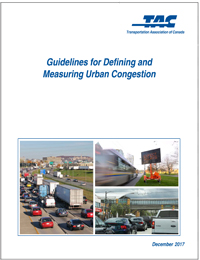The Guidelines for Defining and Measuring Urban Congestion assist practitioners and researchers define, measure, and monitor traffic congestion in urban areas. The Guidelines provide directions on quantifying traffic congestion for both urban freeway and arterial corridors, and are applicable for motorized roadway transportation, including public transit mixed with other motorized modes of transportation. They identify a range of performance metrics to measure and monitor traffic congestion. 29 common congestion measures were identified and categorized, in order to develop an objective procedure that would assess and compare congestion.
The Guidelines are based on both findings from published literature and results from a survey of Canadian and international municipalities with experience in measuring traffic congestion in urban areas.
Background: Traffic congestion has become a major challenge in most urban areas. In recent years, the development of measures to mitigate traffic congestion has become a priority for many road agencies. To this end, identifying congestion characteristics is an essential step in selecting appropriate mitigating measures.
Disponible en français : Lignes directrices pour définir et mesurer la congestion urbaine (2017)

